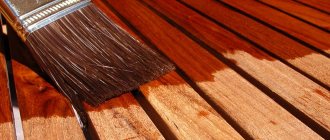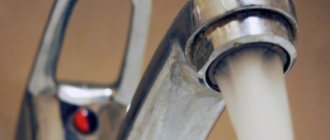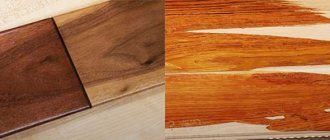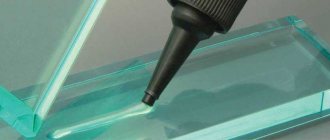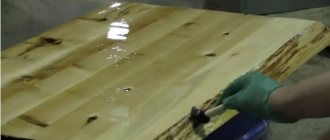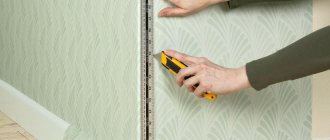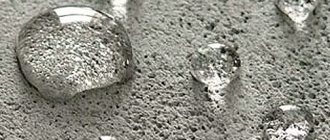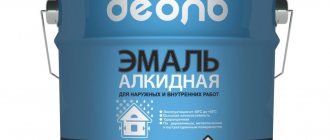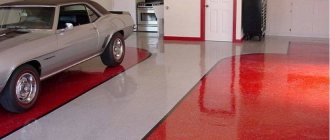Varnish allows you to renew a wooden surface that may deteriorate over time. Many people decide to paint the wood, but in order not to lose the appearance of the natural structure of the wood, it can be varnished.
The varnish coating protects the wood from moisture, mechanical stress, and atmospheric conditions. The products differ in composition, colors and technical characteristics.
How do the compositions differ?
Depending on the operating conditions of the wooden base, the varnish can be used indoors or outdoors. There are compositions that are quick-drying, odorless, frost-resistant, heat-resistant (fire retardant), water-based, oil-based or alcohol-based.
Varnishes come in the following form:
- in cans (aerosol, spray), which are convenient for covering small areas;
- in containers (cans, bottles), applied with a brush, roller, spray gun.
By purpose:
- floor varnishes (parquet);
- for decorating and emphasizing the structure of wood;
- for water transport.
Advantages and features of acrylic varnish
Having a wide range of special properties, acrylic varnish also has its positive qualities:
- the light weight of the material allows you to cover even the thinnest and most fragile surfaces;
- film coating provides additional lasting protection from harmful external factors;
- has components that reliably protect against the possibility of fire;
- moisture-repellent properties make it possible to cover the surface in semi-basements, basements and bathrooms;
- endowed with antibacterial, antiseptic and antifungal properties that actively fight germs and mold growths;
- the surface coated with acrylic varnish acquires a beautiful appearance, easily fitting into the theme of the overall decor;
- has protection against the harmful effects of ultraviolet radiation;
- safe to use due to its environmentally friendly composition.
Varnish colors
The coating can be matte, glossy (with shine), semi-matte and semi-gloss. There are also high-gloss compounds for high shine.
- The most popular transparent varnishes on the market that highlight the natural structure of wood.
- It is possible to give the wood a beige, brown, red, or black color with a walnut shade.
- White varnish and mechagon color make the wood visually more voluminous.
- Tinting varnishes for wood darken the surface, hiding its imperfections. Used for wooden furniture and doors (including interior doors), parquet boards.
copal species
Required ingredients:
- soft, light-colored copal (1 dose);
- turpentine (2 doses);
- camphor (3%).
The third element is needed to give the varnish good elasticity. This composition is placed in three quarters of the bottle. The bottle is thoroughly corked and kept in a warm place, for example, near a radiator. The bottle needs to be shaken periodically. You should get a high-quality solution from all components. It settles and filters. Cotton wool serves as a filter here. If the resulting varnish is not transparent enough, concentrate the bottle in a water bath for 10-20 minutes.
Types of varnishes by composition
The composition determines:
- characteristics of the mixture (drying time, coating thickness, presence or absence of odor);
- conditions of use (for external or internal work).
The price of paintwork depends on these factors, manufacturer and brand.
Oil varnishes for wood
- They are based on oils and resins.
- Dries in 1-3 days.
- Penetrates deeply into the rock.
- For interior work only.
- Process furniture or other wooden objects.
- Not suitable for floor coverings.
The proportion of oil content determines the period of complete hardening of the applied layer.
So, oil varnishes are:
- lean (oil content from 35 to 55%);
- average (from 55 to 65%);
- fatty (from 65 to 85%).
The more oil contained in the composition, the faster the drying, but the greater the susceptibility to wear.
Before applying with a brush, dilute the product to a comfortable consistency, since the mixture is initially too thick.
Artificial resins and oils are now used in production, which has reduced the price of the product. Previously, the composition contained natural oils.
Resin
An ideal alternative to oil based ones. The composition is based on the inclusion of synthetic resins (thermoplastic, thermosetting) and natural (amber).
Alkyd varnishes
They are produced on the basis of alkyd resins, with the addition of solvents (solvent or white spirit) and driers to accelerate drying. Alkyd mixtures are resistant to moisture and temperature changes. They are inexpensive, and their penetration properties into the rock are high.
The applied layer remains on the surface for two to three years. The period of complete polymerization is two days.
Suitable for wooden floors, floating floors, including heated floors, furniture. The compounds are toxic due to the solvent.
It is advisable to work in protective equipment (gloves, respirator).
They are divided into pentaphthalic (PF) and glyphthalic (GF). From the last category, GF-166 and GF-177 are popular. Both representatives have a transparent glossy sheen and harden after 48 hours (GF-177 is faster).
Alcohol
Alcohol varnishes (varnishes) have a narrow scope of application. The composition is based on the content of ethyl alcohol in which the resin is dissolved. This is a quick-drying varnish for wood. Dries in less than 1 hour (20-30 minutes), which is achieved by evaporating the alcohol after applying the layer.
Visually, alcohol mixtures are glossy. Used for coating musical instruments, furniture, leather, glass.
Alkyd-urea
Contains pentaphthalic or glypthal resins, urea. They are two-component and polymerize only after adding an acid-based hardener. Designed for interior work.
They give the surface a strong shine, the coating is highly durable and moisture resistant.
Can be applied to parquet boards or wood floors of any species. They cover indoor furniture.
Epoxy
This is a transparent composition that hardens after adding a hardener to the epoxy resin.
Epoxy varnish on wood is resistant to heavy loads, so it can be used on solid floors, parquet, and can be used to update interior doors or other wooden products.
The composition is moisture resistant and can be used for both interior and exterior work. Dries in half a day.
Polyester
These are multicomponent products based on the inclusion of polyester resins. It is applied with a special gun, so this option is not suitable for beginners. After complete drying, a transparent film of great thickness is formed, which ensures high strength and moisture resistance. Withstands high temperatures and exposure to chemicals.
Wooden musical instruments are usually processed.
Nitrocellulose
Nitrocellulose (or cellulose ether) varnishes contain organic thinners, cellulose nitrate, resins and plasticizers that improve characteristics.
Despite their high resistance to moisture, the mixtures do not withstand atmospheric conditions and do not have great mechanical strength. Over time, the film may peel off from the surface. It can be polished successfully and dries quickly (20-50 minutes).
There are both glossy (NTs-218) and matte (NTs-243) coatings.
Nitrovarnishes are toxic because they contain a solvent. You only need to varnish wood using a respirator and ventilate the room well.
After the solvent has evaporated, the applied layer is safe.
Not used for floors due to weak strength. It is often used to cover wooden furniture, pencils and music. tools. The varnish does not tolerate direct sunlight, so it is better not to use it outside.
Acrylic-urethane
This is a water-soluble, odorless varnish with high adhesion. After drying, the film is resistant to moisture, so you can cover wood in baths, saunas, and apply it in bathrooms. The coating is reliable and durable, does not affect humans, and is safe. It must be used at a temperature not lower than +12 °C, and stored at a temperature below zero, but not less than -5 °C.
Alkyd-urethane
Used as yacht varnishes.
Contains toxic substances (toluene and xylene), the fumes of which affect humans.
This is the best varnish for exterior woodwork, frost-resistant, waterproof, but smells bad. The coating lasts for about five years.
It is not recommended to use indoors. Even after drying, evaporation of substances may continue.
Polyurethane
There are one-component, two- and three-component varnish. The two-component product is prepared before use by mixing with a hardener. The three-component one also contains a solvent.
This is one of the most effective materials in terms of coating strength. But it takes a very long time to dry (2-3 weeks), with a strong pungent odor.
After drying, the layer is resistant to strong mechanical loads, moisture, any atmospheric conditions, chemicals. substances, creates anti-corrosion protection.
External and internal use. Polyurethane varnishes are popular for treating garden structures, yachts and boats, parquet boards, and walls.
Acrylic varnishes
Water-based acrylic varnish provides wood with effective fire protection due to the absence of flammable substances in its composition. These mixtures are odorless, safe for humans, and can be used for opening children's rooms.
They have high adhesion to wood and are vapor permeable, but their strength is not the highest. Water-based varnish is applied only to the primed surface and dries for up to 15 days.
Application is also possible on brick and concrete bases indoors.
Bituminous
Painting wood with bitumen varnish makes it resistant to moisture and acid-base environments.
By default it has a brown tint. The treated surface becomes visually pleasing.
It is applied in a thin layer, and small parts can be coated by dipping.
Tinting mixtures
You can paint a wooden door, furniture, parquet boards. Fulfills a protective and decorative purpose. Visually darkens the wood, giving it the appearance of expensive species, increases the strength of the base and protects against fungus and mold.
Food varnishes
Apply to wooden utensils that come into contact with food. There will be no consequences, the varnish is safe. Suitable for use on cribs and toys.
Beeswax polish
The main ingredients in this recipe are beeswax and alkane root, which is widely used in the preparation of a huge number of cosmetics.
Beeswax is also famous for its properties. It is added to various cosmetic preparations and is widely used in folk medicine.
The tandem of these two substances has a positive effect on nails. They acquire a healthy and well-groomed appearance.
In order to prepare a miraculous varnish, use ¼ teaspoon of beeswax, ½ teaspoon of alkana root and three tablespoons of olive oil.
Vitamin E, well known to all women caring for themselves, will fit perfectly into the mixture, but even without it, the varnish will be quite useful.
Preparation procedure:
- Combine the olive with alkanes root and heat in a water bath.
- After the solution has warmed up, it is cooled for five minutes and passed through a sieve.
- Then beeswax is added to the mixture and sent back to the water bath.
- After the wax has melted, cool the mass. The varnish is ready!
Editor's choice: How to properly apply shellac on nails at home
This very simple recipe will help your nails always look great.
What to consider when choosing
The mixture is selected taking into account the conditions of its use.
- Place of work. Indoors, compositions without toxic components and odorless during drying are selected. For external work, only wood varnishes with high resistance to weather conditions (precipitation, sunlight, frost) are suitable. It is permissible to use materials with an unpleasant odor outdoors.
- Wear resistance. Wooden floors and stairs must be coated with varnishes that have high strength and wear resistance. For furniture, you can choose less durable materials, for example, nitrocellulose.
- Toxicity. For indoor use, it is better to choose water-based mixtures. They are odorless, safe, and used without personal protective equipment. You can choose ones that contain toxic substances, but do not forget about a respirator and protective clothing.
- Drying time. If repairs need to be done quickly, water- or oil-based products may not be suitable. They dry out in up to two weeks. While alcohol and NC compositions dry out in 1-2 days.
- Shine. Matte or gloss does not affect the characteristics and quality of the varnish in any way. The choice depends on the person's preferences.
- Curing methods. Mixtures are divided into one-component ones, which are ready for application. And two-component ones, the drying of which begins after reacting with the hardener. It is better for beginners not to use two-component varnishes, since they need to work quickly and be able to maintain the proportions of mixing the components.
- The need for a primer. Priming the wood increases adhesion to the future paint and varnish material. Without preliminary priming, the dried layer may peel off prematurely. There are varnishes on sale with a pre-priming composition.
Homemade olive varnish
Of course, the main ingredient in this recipe is olive oil. It can take care of not only your hands, but also your nails. In addition, it wonderfully helps soften the cuticle and remove it.
Editor's choice: How to do a pedicure at home: five steps on the path to perfection
The auxiliary component is white clay. It is mixed in the amount of one part with two parts of olive oil. Then the resulting mixture is applied to the nails and left for 15-20 minutes. The varnish is removed with a cotton swab soaked in warm water.
Instead of white clay, you can use colorless henna.
How to calculate varnish consumption for 1 m2 of wood
Average cost to cover sq. m. wood approximately 100-125 ml. The numbers are relevant for an ideal surface and are always individual.
Several factors affect consumption.
- Viscosity of the product. More viscous mixtures require more consumption. They are more difficult to apply; part of the solution remains on the bristles of the brush. Uniformity is also in question. The problem is solved by diluting it to a more liquid consistency. Water-based varnish is thinned by it. Other mixtures are diluted according to the instructions. Solvents are used.
- Wood surface. The finely porous base absorbs less material, which means consumption is reduced. The size of the pores depends on the type of wood and its age.
- Sanding quality. Cleaned, sanded wood is easier and faster to varnish and less material is required. Sand with a grinder and abrasive wheels or sandpaper with P100 grit. Better adhesion of the first layer to the second (with two-layer application) is ensured by sanding it, for example, with P220 grain.
- Application method. The spray gun reduces consumption, but it is important to maintain the required viscosity of the product. Excellent for processing large areas. A roller or brush is wasteful, the layer is thicker, and part of the paint and varnish material remains on the pile.
You can correctly calculate the required amount of mixture for varnishing wood experimentally. Buy a small container of the product and treat 1 m2 of surface with it. After complete drying, with a satisfactory result, you will know the exact consumption. You can reduce it using the tips above.
Floor preparation and varnishing
Before you start varnishing, you need to clean the surface so that it is free of grease stains, dirt, dust and moisture. It is advisable to sand the floor with an electric tool so that the base is even and smooth. The varnish must be applied at an air temperature of at least +10 degrees and air humidity from 50 to 80%.
If there are gaps, cracks, craters, and other defects on the wooden floor, they must be puttied with a special solution. After puttying, the surface is sanded, then the dust is carefully removed with a vacuum cleaner. It is advisable to apply a special primer before applying the varnish mixture.
The container with varnish must be thoroughly stirred and shaken so that the liquid acquires a uniform consistency. The application process can be performed with a brush, roller, spray or pouring method. You can pour the varnish onto the surface and spread it evenly with a spatula, in the direction of the wood fibers. During application, it is important to ensure that no puddles appear. After the first layer has dried, it is advisable to sand it with sandpaper, then remove all dust with a vacuum cleaner, and apply one or two more layers for maximum protection. If the mixture thickens, it can be diluted with plain water.
Useful tips
- Before using paints and varnishes, shake and mix well.
- You cannot add a solvent to the finished composition - only water.
- Acrylic varnishes can be matte or glossy.
- Before starting varnishing, it is advisable to check the compatibility of a particular paintwork material with the coating. This can be done somewhere inconspicuously, for example, under furniture.
- High-quality drying is impossible in drafts or direct sunlight.
- At the late stage of drying, when the varnish seems to have already dried, it is better to walk on the floor in soft shoes or socks.
- To prevent damage to the surface, felt pads should be placed on furniture legs.
- To prevent the formation of bubbles or defects, the penultimate layer should be lightly sanded or scraped. Next you need to apply one or two layers of varnish on top.
- The technology involves applying each subsequent layer no earlier than after 12 hours. If the room temperature is too low or the humidity is high, the drying time must be increased.
- If the goal is to achieve decorative effect, the most proven method is to apply two layers of varnish to a primed surface.
- When working with paintwork materials, you need to use safety glasses and gloves.
- Acrylic varnish should be stored in closed original packaging. Optimal temperature: from 5 to 30 degrees Celsius.
There are a large number of companies on the market, both Russian and Western. The choice of a specific brand of acrylic varnish for wood often depends on commitment to a particular manufacturer or on the price of the product.
